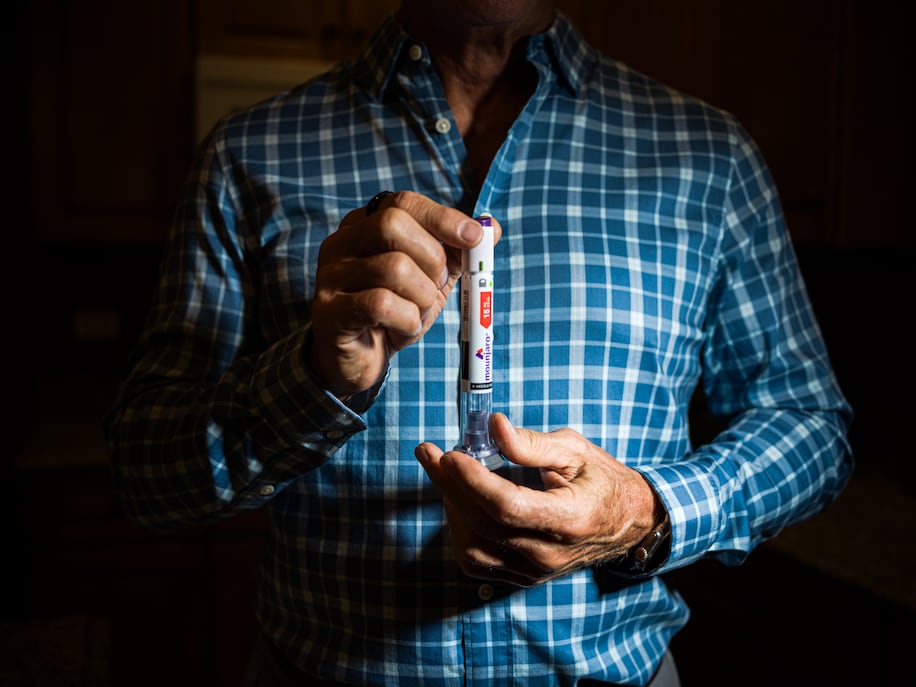The Chicago lawyer John DrewsLike many high-income Americans, he tended to allocate a generous budget to discretionary spending. His shopping priorities included Scotch whisky, chocolates, pretzels, dinners out and beach resort holidays.
However, in May 2022, after seeing reports from celebrities and influencers about the impact of weight loss drugs, she decided to try one of these treatments and her life changed completely.
In the first year he lost 25 pounds (11 kg) and in the second, 75 pounds more (34 kg). From then on, Drews not only felt like a different person, she practically became one, with completely new habits in terms of eating, dressing, exercise and holidays. Her spending habits changed dramatically, from indulgent meals to spending more of her money on food. 100,000 per year in their new wellness routine. "It's a whole new life.says Drews.
This is just one individual case, but if you multiply their experience by the approximately 16 million Americans (around 6 % of adults in the US) who are using GLP-1 drugs as Ozempic, Mounjaro, Wegovy and ZepboundThe potential economic impact is enormous.

A change in consumer habits
Research suggests that users of these drugs belong to a group of consumers who are above-average spenders. By halving or more their daily calorie intake, their purchasing decisions are generating unexpected consequences in a number of sectors.
According to a study by Cornell University and Numeratorconsumers of LPG-1 are spending less in cafeterias and fast food chains. On the other hand, a report by PricewaterhouseCoopers (PwC) reveals that the 35 % of users of these medicines have started exercising for the first time or have increased their physical activity, and the 16 % has hired a personal trainer.
Companies are already adjusting their strategy to this new reality. Walmart has detected a slight reduction in the amount of food purchased by some customers. Rent the RunwayThe luxury clothing rental retailer has seen an increase in demand for smaller sizes and slim-fit garments. Life Time Inc.the upscale gym chain where Drews trains, has launched a programme that includes metabolic testing, nutritional counselling and prescription of GLP-1 drugs when needed.
From restaurants to high-level nutrition
Drews, a native of the Midwest, worked in the steel industry before going to law school. His professional success led him to a life of high demands, with long hours, long hours and long hours. 16 hours a day, six days a weekThe health of the children was put on the back burner. At the 63 yearswith a height of 1.80 metresreached a weight of 130 kg and his doctor warned him that he was on the brink of developing hypertension and type 2 diabetes. In addition, her physical condition prevented her from enjoying activities such as hiking with her adult children.
Everything changed with the introduction of GLP-1 drugs into his routine. Initially, he lost weight effortlessly by reducing his appetite. But when her doctor warned her about the importance of preserving muscle mass, Drews doubled its investment in health:
- Hired a personal trainer by 140 per hourtwice a week.
- Incorporated sessions of cardio, pilates and swimming.
- He would get up at 4:30 a.m. to train in the gym.
His eating habits changed drastically. He used to eat on impulse, without worrying about nutritional value. Now his diet is precise and optimised:
- BreakfastEggs, oatmeal with blueberries and banana.
- LunchVenison: lean venison or bison with vegetables.
- Dinnersalmon, sweet potato, Brussels sprouts and broccoli.
- Snacksyoghurt with cocoa and nuts.
- Beveragesonly water, coffee and matcha tea.
The change was not deliberate, but a natural consequence of the drug. Like many GLP-1 users, he stopped cravings and the concept of "pleasure in food" disappeared. "I used to eat M&M's for no reason. Now I don't even remember what I used to eat".
Impact on the food and retail industry
Changes in consumer habits are affecting the food industry significantly. Companies such as Nestlé are committed to the creation of meal replacements y protein-rich products aimed at people who eat less but prioritise nutrition. Meal delivery platforms such as CookUnity and Daily Harvest have developed specific lines for GLP-1 users, with smaller but more nutrient-dense portions.
According to Grocery Doppiothe purchase of lean meats increased by 27 % in the first half of 2024while sales of whole fruit and vegetables were up by 13 %. In contrast, sales of ultra-processed products, sweets and industrial pastries have fallen by between 47 % and 52 %..
Drews, for example, has increased their expenditure on foodbut now spends its money on premium products. Its main meat is the deer or bisonwhich buys from 31 dollars per pound (as opposed to the 5 USD of conventional beef). "When you can only eat a few ounces of meat, why not choose filet mignon?"The KPMG on GLP-1 consumers.

Personal transformation and new consumer habits
As her body changed, so did her clothing shopping habits. She had to replace her entire wardrobe three timesfrom size XXL to M. He started to buy sportswear from premium brands such as LululemonHe is a specialist in the field of health and wellness, prioritising quality and fit. His focus on wellness led him to become interested in the science of longevity. Currently, he reads books such as "Burnof Herman Pontzerwhich looks at how the human metabolism does not respond in the traditionally expected way to physical activity.
From resort holidays to wilderness adventure
Even their travel preferences have changed. In the past, their ideal holiday was at resorts all-inclusive in Mexico or the Caribbeanwhere the main activity was relaxing by the water.
Now, instead of choosing a destination focused on leisure and food, she opted for an active trip with her son. At eight daysthey toured 77 miles (124 km) in national parks such as the Grand Canyon, Bryce and Zion. "I was leading the hike - me, overtaking my son on a climb!"he relates with enthusiasm (Source The Whashington Post)
Is it the same in Europe?
Not yet. In the United States, the rise of GLP-1 drugs is having an impact beyond individual healthtransforming consumer behaviour and reshaping entire sectors of the economy. From food to tourism, fashion and fitness, companies must adapt to this new reality where consumers prioritise quality over quantity, nutrition on indulgence y activity on sedentary lifestyles.
As more people adopt these treatments, the market will continue to adjust to their new needs, creating opportunities in sectors such as personalised nutrition, premium sportswear and active tourism.
In Europe, Ozempic, Mounjaro and Wegovy, have gained popularity due to their effectiveness in ending weight loss itself. However, this trend has generated concerns and side effects that are being widely discussed.
One of the most prominent side effects is the so-called "side effect".Ozempic side"which refers to facial sagging and ageing after rapid weight loss. This phenomenon has led to an increase in demand for aesthetic treatments to restore facial firmness and volume. Specialists recommend gradual weight loss to minimise these adverse effects, and solutions include hyaluronic acid or fat fillers, as well as radiofrequency and ultrasound technologies.

Misuse and supply problems
The popularity of these medicines has led to their use by people without obesity or type 2 diabetes, especially after festive periods such as Christmas, in order to lose weight quickly. This inappropriate use has led to supply problems, affecting those who really need them. The European Medicines Agency (EMA) has warned about this misuse and urged that these drugs should only be used under medical supervision.
Warnings from health authorities
The EMA has emphasised that GLP-1 receptor agonists are not approved for weight loss in people without obesity or type 2 diabetes and that GLP-1 receptor agonists are not approved for weight loss in people with type 2 diabetes. has underlined the need to avoid promotional activities that may encourage inappropriate use. In addition, it has called on healthcare professionals to prioritise those patients most in need of these medicines and to consider alternatives such as lifestyle changes before prescribing them to people without the indicated medical conditions.
Although GLP-1 drugs are revolutionising the treatment of obesity in Europe, their misuse and cosmetic side effects are raising significant concerns. European health authorities are taking steps to ensure their appropriate use and avoid supply problems, emphasising the importance of medical supervision and the adoption of healthy lifestyle habits as essential components of weight management.
In Spain, the market for these drugs has experienced significant growth, reaching a value of more than 430 million euros in 2024, with more than 5.5 million units sold, of which more than 50% were for the treatment of obesity. This increase has led to a forecast of changes in food consumption habits, with a possible decrease in demand for ultra-processed products and an increase in preference for healthier, protein-rich foods.
At the European level, reports indicate that the costs associated with obesity, including healthcare costs and productivity losses, significantly outweigh the cost of these new drugs. for weight loss. For example, a report by ING bank notes that in countries such as the UK, Germany and the Netherlands, the adoption of these drugs could have clear economic benefits by reducing obesity-related medical complications and improve labour productivity.
In addition, the European GLP-1 agonist market is expected to grow at a CAGR of 5.90%, from USD 3.94 billion in 2024 to USD 5.25 billion in 2029. This growth reflects increased adoption of these treatments in the region.
However, it is important to note that although these drugs have been shown to be effective in weight loss, its high cost and potential side effects limit its accessibility and widespread use. In addition, experts underline the need to address obesity through comprehensive approaches including lifestyle changes, such as a balanced diet and regular exerciseinstead of relying solely on pharmacological solutions.
In summary, Europe is experiencing economic trends similar to those in the US in relation to the use of GLP-1 drugs, with a growing market and potential changes in consumer habits and in the food industry. However, comprehensive strategies are required to effectively address obesity and its economic and social implications.






